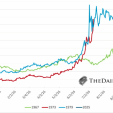Monetary Policy Madness?
In a recent newsletter John Mauldin wrote: “It is monetary policy madness to raise rates and undertake quantitative tightening at the same time.” However, this is exactly what the Fed plans to do in 2018. Has the Fed gone mad?
If mad is defined as diverging in an irrational way from normal practice then the answer to the above question is no. The Fed is following the same rule book it has always followed.
It should first be understood that earlier rate-hiking campaigns were always accompanied by quantitative tightening (QT). Otherwise, how could the Fed have caused its targeted interest rate (the Fed Funds rate) to rise? The Fed is powerful, but not powerful enough to command the interest rate to perform in a certain way. Instead, it has always manipulated the rate upward by reducing the supply of reserves to the banking system via a process that also reduces the money supply within the economy; that is, via QT. In other words, far from there being something unusual about the Fed simultaneously raising rates and undertaking QT, it is standard procedure.
What’s unusual about the current cycle is the scale. Having created orders of magnitude more money and bank reserves than normal during the easing part of the cycle the Fed must now implement QT on a much larger scale than ever before. At least, that’s what the Fed must do if it follows its rule book.
A plausible argument can be made that the Fed should now deviate from its rule book, but the argument isn’t that the economy is too weak to cope with tighter monetary policy. The correct argument is that the damage in the form of misdirected investment and resource wastage was done by the earlier quantitative easing (QE) programs and this damage cannot be undone or even mitigated by deflating the money supply. In effect, the incredibly loose monetary policy of 2008-2014 has made a painful economic denouement inevitable. At this point, reducing the money supply — as opposed to stopping the inflation of the money supply, which would be beneficial as it would prevent new mal-investment from being added to the pile — would exacerbate the pain for no good reason.
In other words, the damage done by monetary inflation cannot be subsequently undone by monetary deflation.
A plausible argument can also be made that for the first time ever the Fed now has the option of hiking interest rates without doing any QT. This is due to its ability to pay interest on bank reserves. This ability was acquired about 9 years ago solely for the purpose of enabling the Fed to hike its targeted interest rate while leaving the banking system inundated with “excess reserves” (refer to my March-2015 blog post for more detail). That is, this ability was acquired so that the Fed would not be forced to undertake QT at the same time as it was hiking rates.
However, the Fed is not going to deviate from its rule book. This is mainly because the Fed’s leadership believes that a new QE program will be required in the future.
To explain, a Fed decision not to implement QT would create an expectations-management problem in the future. Specifically, an announcement by the Fed that it was going to maintain its balance sheet at the current bloated level would be a tacit admission that QE involved a permanent addition to the money supply rather than a temporary exchange of money for securities. If the Fed were to admit this then the next time a QE program was announced there would be a surge in inflation expectations.
There has been monetary policy madness in spades over the past two decades, but within this context there is nothing especially mad about the Fed’s plan to raise rates and undertake quantitative tightening at the same time.
*********






 Steve Saville graduated from the University of Western Australia in 1984 with a degree in electronic engineering and from 1984 until 1998 worked in the commercial construction industry as an engineer, a project manager and an operations manager. In 1993, after studying the history of money, the nature of our present-day fiat monetary system and the role of banks in the creation of money, Saville developed an interest in gold. In August 1999 he launched The Speculative Investor (TSI) website. Steve Saville has lived in Asia (Hong Kong, China and Malaysia) since 1995 and currently resides in Malaysian Borneo. Visit his website at
Steve Saville graduated from the University of Western Australia in 1984 with a degree in electronic engineering and from 1984 until 1998 worked in the commercial construction industry as an engineer, a project manager and an operations manager. In 1993, after studying the history of money, the nature of our present-day fiat monetary system and the role of banks in the creation of money, Saville developed an interest in gold. In August 1999 he launched The Speculative Investor (TSI) website. Steve Saville has lived in Asia (Hong Kong, China and Malaysia) since 1995 and currently resides in Malaysian Borneo. Visit his website at 










